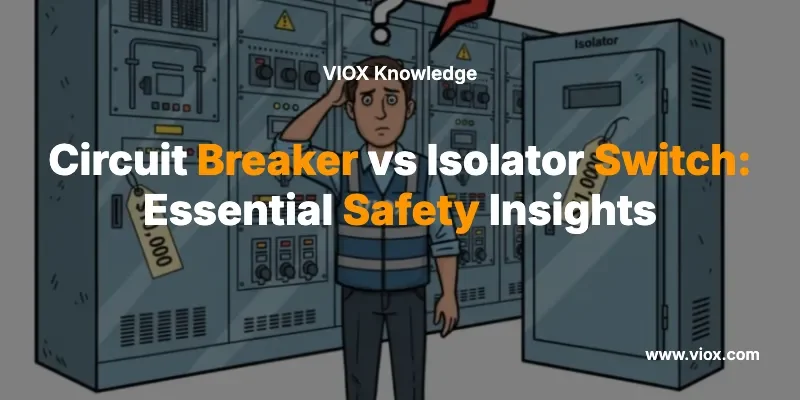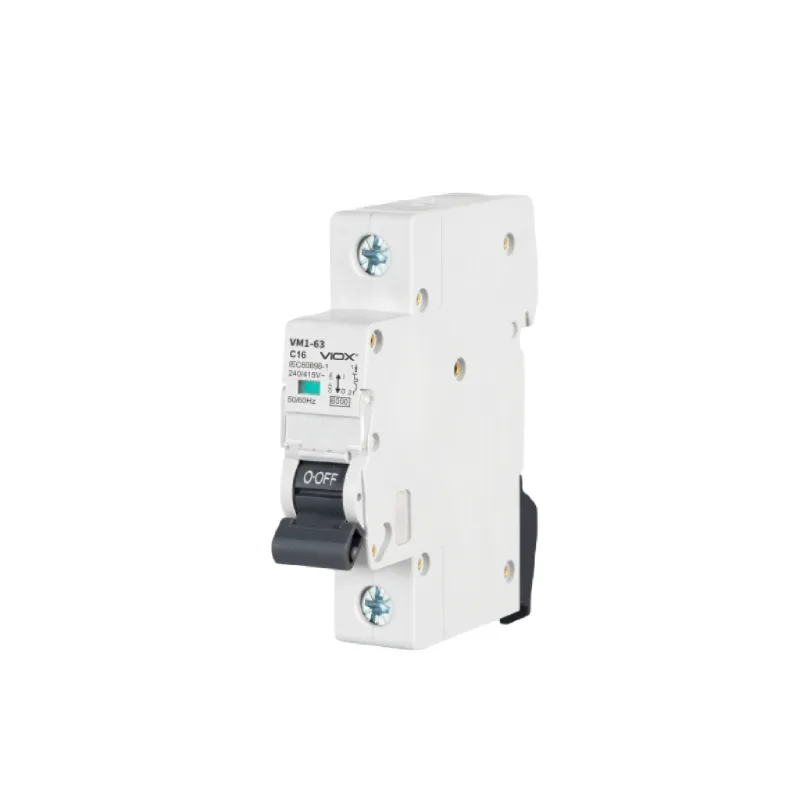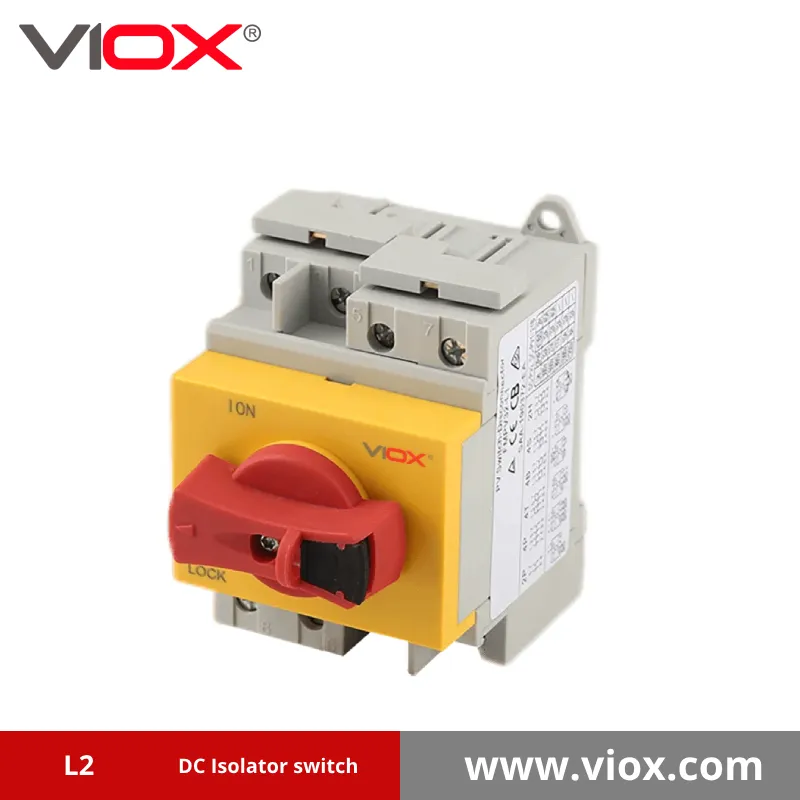As an engineer or facility manager, you’re looking at a high-voltage switchgear lineup. You see a large, complex เบรกเกอร์. Right next to it, you see a simpler, manually-operated switch labeled “Isolator” หรือ “Disconnector.”
They both appear to “disconnect” the circuit. They both look like switches. But one costs ten times more than the other, and this isn’t a simple “good-better-best” scenario.
Here’s the complication: using one in place of the other is a catastrophic, potentially fatal mistake. Using an isolator to interrupt a live load—especially a fault current—will cause a violent arc flash, destroying the equipment and severely injuring or killing the operator.
So, what is the non-negotiable, fundamental difference between a circuit breaker and an isolator? And more importantly, how do you design a safe system that uses both correctly?
The Two Missions: Protection vs. Isolation
Before you can specify the right device, you must understand that circuit breakers and isolators operate on fundamentally different missions. This isn’t about features—it’s about purpose.
เบรกเกอร์: The Automatic Guardian (Fault Protection)
A circuit breaker is an automatic protective device designed to safeguard electrical circuits from damage caused by overcurrent conditions—overloads and short circuits.
How it works:
- During normal operation, current flows through closed contacts inside the circuit breaker
- A detection mechanism continuously monitors current levels (thermal element for overloads, magnetic coil for short circuits)
- When current exceeds safe thresholds, the detection mechanism triggers a tripping mechanism
- The circuit breaker automatically opens its contacts within milliseconds
- An integrated arc suppression system (oil, vacuum, SF6 gas, or air) safely extinguishes the electrical arc generated during interruption
- The circuit is now open—no current can flow until the breaker is manually reset
The mission: Protect equipment, wiring, and property by automatically disconnecting power the instant a fault occurs. Circuit breakers are on-load devices—they’re designed to interrupt current while it’s flowing, which requires sophisticated arc suppression technology.
Critical characteristics:
- Automatic operation: No human intervention required during faults
- On-load interruption: Can safely break circuits carrying full load current or fault current
- Arc suppression: Contains arc extinguishing systems to handle the plasma arc created when breaking current
- Resettable: Can be reset and reused after tripping (unlike fuses)
- Fast response: Trips within milliseconds to microseconds depending on fault severity
The fatal limitation for maintenance safety: Circuit breakers are NOT designed to guarantee zero voltage. They’re optimized for fast automatic interruption during faults, not for providing visible, verifiable isolation during maintenance. Internal contact mechanisms can develop faults. Mechanical linkages can fail partially. Residual voltage can remain even in the “off” position.
Pro-Tip : Never trust a circuit breaker alone for maintenance safety. Circuit breakers protect equipment from faults—they don’t protect technicians from circuits. Even when a circuit breaker is “off,” treat the circuit as potentially energized unless an isolator switch provides visible physical disconnection.
สวิตซ์แยก: The Maintenance Gatekeeper (Safe Isolation)
An isolator switch (also called a disconnector) is a manual device designed to provide visible, physical isolation of electrical circuits from power sources during maintenance, inspection, or repair.
How it works:
- Before operation, the circuit must be de-energized (load current must be zero)
- An operator manually opens the isolator using a handle or operating mechanism
- The isolator creates a visible air gap between contacts—you can physically see the disconnection
- This air gap provides absolute assurance that no current can flow
- Some isolators include position indicators or mechanical interlocks to prevent accidental closing
- The isolated circuit section can now be safely worked on with zero risk of electrical contact
The mission: Guarantee zero voltage during maintenance by creating visible, physical separation from power sources. Isolators are off-load devices—they must never be operated while current is flowing because they lack arc suppression systems.
Critical characteristics:
- Manual operation: Always requires deliberate human action
- Off-load only: Can only be operated when circuit current is zero (circuit breaker must open first)
- Visible isolation: Creates an air gap you can physically see and verify
- No arc suppression: Not designed to interrupt current—will create dangerous arcing if operated under load
- Position indication: Often includes visible open/closed status indicators
- Lockout capability: Can be mechanically locked in the open position for safety
The fatal limitation for fault protection: Isolators cannot protect against electrical faults. They have no automatic detection, no arc suppression, and no ability to safely interrupt fault currents. Operating an isolator under load causes catastrophic arcing that destroys the device and creates fire hazards.
Key Takeaway : Isolators and circuit breakers must work as a team. Circuit breakers handle automatic fault protection during operation. Isolators provide visible safety isolation during maintenance. Trying to use one device for both missions creates dangerous gaps in either operational protection or maintenance safety.
The Engineer’s 3-Step Framework: Correct Specification and Operation
Now that you understand the fundamental missions, here’s the systematic framework for ensuring both devices are correctly specified, installed, and operated in your electrical systems.
Step 1: Map Your Dual Requirements (Protection AND Isolation Analysis)
Every electrical circuit in your facility needs to answer two separate questions:
Question 1: “What protection does this circuit need during operation?”
This determines your circuit breaker requirements:
- Overcurrent protection rating: What’s the maximum safe operating current? What’s the short-circuit breaking capacity required?
- Response speed: Does this circuit serve sensitive electronics requiring ultra-fast protection (electronic trip), or standard industrial loads (thermal-magnetic)?
- Special protection: Does this circuit require ground fault protection (GFCI), arc fault protection (AFCI), or motor-specific protection?
Question 2: “Will maintenance personnel ever need to work on this circuit while it’s energized elsewhere?”
This determines your isolator requirements:
- High-risk circuits: Any circuit serving equipment requiring regular maintenance (motors, control panels, lighting systems, HVAC units) needs isolators
- Safety-critical locations: Circuits in hazardous environments (flammable areas, wet locations, high-voltage systems) require isolators with lockout capability
- Accessibility: Isolators must be positioned where maintenance personnel can easily access and verify the visible open position
The critical insight: Almost every industrial and commercial circuit needs both devices—a circuit breaker for automatic fault protection during operation, plus isolators for safe maintenance isolation. Residential circuits typically need only circuit breakers because homeowners don’t perform maintenance on energized systems.
Decision Matrix:
| ประเภทวงจร | Circuit Breaker Required? | Isolator Required? | Typical Configuration |
|---|---|---|---|
| Motor control circuits | ✓ Yes (motor-rated) | ✓ Yes (both sides) | Isolator → Circuit Breaker → Isolator → Motor |
| Lighting panels (commercial) | ✓ Yes | ✓ Yes | Isolator → Circuit Breaker → Lighting distribution |
| Transformer feeders | ✓ Yes (high breaking capacity) | ✓ Yes (both sides) | Isolator → Circuit Breaker → Isolator → Transformer |
| อุปกรณ์ HVAC | ✓ Yes | ✓ Yes | Isolator → Circuit Breaker → Equipment disconnect |
| Residential branch circuits | ✓ Yes | Usually No | Panel circuit breaker only |
| Data center equipment | ✓ Yes | ✓ Yes (redundant) | Multiple isolation points |
Pro-Tip : For critical equipment like large motors or transformers, always specify isolators on BOTH sides of the circuit breaker. This dual-isolation configuration allows maintenance on the circuit breaker itself while keeping the rest of the system energized, and provides redundant safety isolation from both the source and load sides.
Step 2: Design the Sequential Operating Procedure (The Life-Saving Order)
Here’s where maintenance accidents happen: operating circuit breakers and isolators in the wrong sequence. The correct sequence is non-negotiable and must be enforced through training, signage, and mechanical interlocks where possible.
Critical Rule: The “Load-Last, Source-First” Principle
When disconnecting power (preparing for maintenance):
- First: Open the circuit breaker (this interrupts the load current safely using arc suppression)
- Second: Verify zero current (use ammeter or current indicator)
- Third: Open the isolator(s) (now safe to operate because current is zero)
- Fourth: Verify visible open position (physically see the air gap)
- Fifth: Lock out the isolator and tag (prevent accidental re-energization)
- Sixth: Test for voltage (use voltage tester to confirm zero voltage)
When reconnecting power (returning to service):
- First: Remove lockout/tagout from isolator
- Second: Close the isolator(s) (safe because circuit breaker is still open)
- Third: Verify isolator closed position
- Fourth: Close the circuit breaker (this safely energizes the circuit)
Why this sequence is life-or-death critical:
- ❌ WRONG SEQUENCE (DEADLY): Opening an isolator before opening the circuit breaker forces the isolator to interrupt load current. Without arc suppression, this creates:
- Sustained electrical arcing between isolator contacts
- Extreme heat (arcs can reach 35,000°F / 19,000°C)
- Explosive vaporization of contact material
- Severe burns to operators
- Damaged or destroyed isolator
- อันตรายจากไฟไหม้
- ❌ WRONG SEQUENCE (DEADLY): Closing a circuit breaker before closing isolators attempts to energize a system through an open isolator, which can cause:
- Flashover across the isolator air gap
- Equipment damage from voltage transients
- Operator confusion about system state
Pro-Tip: Install mechanical interlocks that physically prevent opening isolators until the circuit breaker is open first. These Kirk Key systems or trapped-key interlocks eliminate the human error factor by making it mechanically impossible to perform the wrong sequence. For high-voltage or high-risk systems, interlocks aren’t optional—they’re mandatory.
The operational sequence rule (never violate):
De-energizing: Circuit Breaker OPEN → Isolator OPEN → Lock → Test → Work
Re-energizing: Isolator CLOSE → Circuit Breaker CLOSE
Make the wrong choice—use a circuit breaker alone for maintenance—and you risk the 3 AM call about a maintenance fatality. Make the right choice using this framework—specify both devices, implement correct sequential procedures, audit for compliance—and you build electrical systems that protect both equipment during faults and personnel during maintenance.
The cost difference between proper and improper protection is minimal: Adding isolators to a circuit breaker might add $150-300 per circuit. The cost of a maintenance accident or equipment failure runs into hundreds of thousands in liability, downtime, and regulatory penalties.
Ready to audit your facility’s electrical safety? Use the Step 3 checklist to identify circuits lacking proper isolation, review your lockout-tagout procedures against the sequential requirements, and specify the combination of circuit breakers AND isolators that provides complete protection. Your maintenance team’s safety depends on it.
Frequently Asked Questions: Circuit Breaker vs Isolator Selection
Q: Can I use a circuit breaker as an isolator during maintenance to save money?
A: No. This is the #1 fatal mistake in electrical safety. Circuit breakers protect against faults but don’t guarantee zero voltage during maintenance. Internal contacts can fail to fully separate, residual voltage can remain, and there’s no visible verification of isolation. Always use a dedicated isolator with visible open position for maintenance safety. The cost of adding an isolator ($50-200) is trivial compared to liability and regulatory penalties from a maintenance accident.
Q: Why do I need isolators on BOTH sides of a circuit breaker?
A: Dual isolation serves three critical functions: (1) Source-side isolator allows safe maintenance on the circuit breaker itself, (2) Load-side isolator allows safe maintenance on equipment while keeping the breaker energized for testing, and (3) Redundant safety if one isolator fails. For motors above 10 HP and critical equipment, dual isolation is required by electrical codes (NEC 430.102, IEC 60947-3).
Q: What happens if I accidentally open an isolator while current is flowing?
A: Catastrophic arcing. Because isolators lack arc suppression systems, opening under load creates a sustained electrical arc that can reach 35,000°F, causing severe burns, destroying the isolator, welding contacts together, and creating fire hazards. This is why mechanical interlocks that prevent opening isolators until the circuit breaker opens first are mandatory for high-risk installations.
Q: How do I verify an isolator is truly open and the circuit is de-energized?
A: Use the “Look-Lock-Test” procedure: (1) Look at the isolator handle/indicator to confirm visible open position and see the physical air gap if possible, (2) Lock the isolator in open position with a padlock and apply your personal tag, (3) Test for voltage using a properly rated voltage tester at the work location. Never trust a single method—combine visual verification, physical lockout, and electrical testing.
Q: What’s the correct sequence when returning equipment to service?
A: Reverse the isolation sequence: (1) Remove lockout devices and tags from isolator, (2) Close the isolator switch (safe because breaker is still open), (3) Verify isolator closed position, (4) Stand clear and close the circuit breaker from a safe distance, (5) Verify normal operation. Never close the circuit breaker before closing isolators—this attempts to energize through an open isolator and can cause flashover.
Q: Do residential electrical panels need both circuit breakers and isolators?
A: Residential panels typically use only circuit breakers because homeowners don’t perform maintenance on energized systems—they call electricians who use proper lockout-tagout procedures on the main service disconnect. However, for residential installations with motors (pool pumps, HVAC units) or workshops where homeowners do their own work, adding a visible disconnect switch near the equipment provides important safety.
Q: What are mechanical interlocks and when are they required?
A: Mechanical interlocks (Kirk Key systems, trapped-key interlocks) physically prevent operators from opening isolators until the circuit breaker is open first, and from closing circuit breakers until isolators are closed. They eliminate human error by making the wrong sequence mechanically impossible. Interlocks are mandatory for: high-voltage systems (>1000V), hazardous locations, critical infrastructure, and any installation where operator error could cause death or serious injury. For industrial facilities, interlocks are best practice even where not legally required.









